
Paladin- Core Additions
Resistance Aura

Auras are a new type of spell that will become a signature trait for the Paladin class. They carry effects that persist for multiple turns. Their ‘tick’ occurs at the end of the Paladin’s turn, so if an Aura lasts for three turns, that counts the turn it was cast in.
This is important to understand because even though Resistance Aura reads that it lasts for three turns, it essentially only debuffs the opponent for two. The card can provide some temporary disruption to a spell-centric deck, but it doesn’t compare too favorably to Cult Neophyte, a card that’s only seen play in proactive decks that look to pressure opponents.
Neophyte lasts for 1 turn, but it has a body attached to it. Resistance Aura has no impact on the board, so it’s useless if your opponent simply develops minions on those turns. Moreover, even if they play a couple of spells, they’ll only ‘waste’ as much mana as you did by casting Resistance Aura.
This aura is simply not great. An aggressive deck is not going to play this because it’s not even as good as a fringe card (Neophyte), while slower decks are even less likely to benefit from it because they’re worse at pressuring the opponent through the board.
Score: 1
Crusader Aura

Crusader Aura is a different story. Whenever you attack with a minion, it gets a +2/+1 buff. This buff occurs before the attack resolves! This means that if you have a 1/1 on the board and you attack the opponent’s face with it, it will deal 3 damage.
Crusader Aura is basically a board buff/finisher that lasts for three turns and only costs 4 mana. On top of that, it also works on rush minions in subsequent turns that just enter the board. Compare this to Grave Strength, Bloodlust, and other board-based finishers, and it looks like an incredible card.
Crusader Aura should become a meta defining win condition for every Paladin deck that looks to aggressively flood the board. In fact, it’s the type of card that helps create these archetypes or help them re-emerge. Dude Paladin just became a lot more interesting thanks to Crusader Aura, while Mech Paladin can be built in a very different direction to best leverage this finisher. Huge addition to the core set.
Score: 4
Paladin
Inventor’s Aura
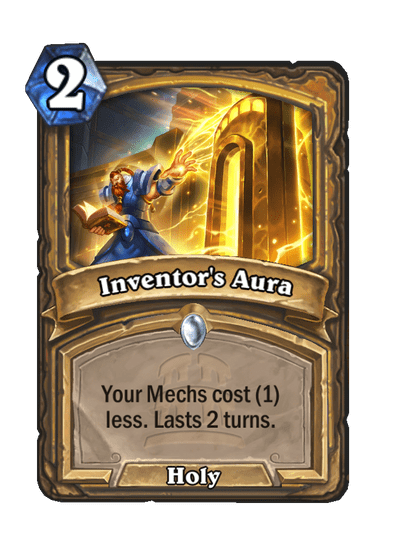
Mechwarper’s Aura. This spell allows the Mech Paladin to go ham with board development in the early game. Inventor’s Aura may not have a body attached to it, but it cannot be removed from play, and Paladin can build its deck with a very low curve that leverages it to the max. Paladin can easily cheat out a huge amount of mana for the two turns this is active.
What’s more is that Mech Paladin has great card draw, with both Radar Detector and Magatha, available to reload the hand after such a play. Paladin also got Crusader’s Aura, which is a fantastic payoff to flooding the board extremely aggressively. Everything is lined up for Inventor’s Aura to revitalize and reinvent the archetype. It’s going to be very hard to outpace the Mech Paladin thanks to this card.
Score: 4
Noble Minibot

2-mana buffs can be very effective at snowballing a turn 1 advantage and put early threats out of the opponent’s removal reach. You can compare this card to Doggie Biscuit. Noble Minibot provides the same number of stats as a buff, but also carries a repeatable handbuff ability that can trigger immediately on the turn it’s played and demands removal from the opponent or risks taking over the early game. Add the fact that it can act as a standalone 2-drop in some cases, can be played for 1-mana with Inventor’s Aura, and you’ve got a strong case that this is one of the best magnetic mechs in the game.
This should be another sizeable boost in Mech Paladin’s power.
Score: 3
Astral Serpent

A 4 mana 3/3 that draws two cards when it enters play is decent, though it’s important to note that drawing cards at the end of the turn is much worse than drawing them with a battlecry. Once you get to the later stages of the game and you’re looking for a play, Astral Serpent is slow at helping you out.
Astral Serpent is a small body as a 3/3, but it is a must-kill target, as the Paladin can choose not to attack with it if it’s ignored and draw more cards. The main synergy that comes with Serpent in this set is Paladin’s resurrection cards. Resurrect an Astral Serpent and you get to draw two cards that turn. It does compete for resurrection from Tyr with a key piece of the Earthen package in this set, but it’s still a good resurrection candidate for Tyr’s Tears.
Would this be a good card in other Paladin decks? Pure Paladin might consider this an upgrade from Muckborn Servant, though its dragon tag means you’re not guaranteed to draw Anachronos from Purator. It could be a bit slow for faster Paladin decks, but there isn’t an abundance of card draw in the class, so it might sneak in. It’s serviceable.
Score: 2
X-21 Repairbot

Repairbot makes for a very good pairing with Noble Minibot. This is a 1 mana 1/3 mech that gives back any magnetic mechs you buffed it with once it dies. That could help Mech Paladin gain card advantage and continue to sustain its pressure. You can trade a magnetized Repairbot into an opponent’s minion and then buff another mech in play on the same turn with whatever magnetic mech you get back from its deathrattle.
Ironically, we don’t think magnetizing is going to be a huge proponent of Mech Paladin decks going forward since both Inventor’s Aura and Crusader’s Aura encourage the archetype to go wide rather than go tall. If Mech Paladin persists with its older playstyle, Repairbot should be a fantastic fit. If Mech Paladin adopts an Aggro Druid playstyle, Repairbot is still a cheap mech that costs 0 mana with Inventor’s Aura and has an occasionally relevant ability. It’s a good 1-drop for the archetype.
Score: 3
Stoneheart King
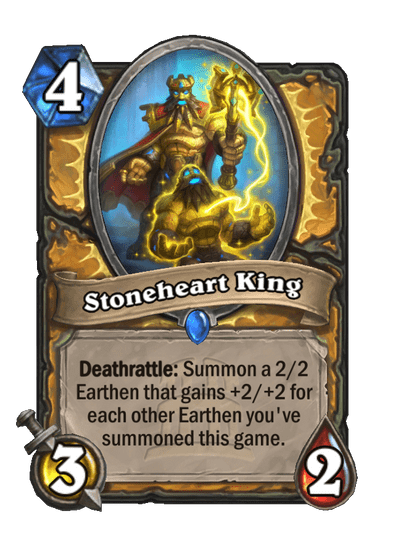
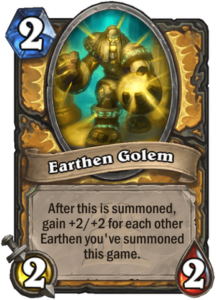
Stoneheart King is the first card in the Earthen package. Earthens are token minions that scale up based on each other Earthen you’ve summoned in a game. The ability triggers after an Earthen is summoned and occurs once. The first Earthen is a 2/2, the second Earthen is a 4/4 and so on.
This means that if you play Stoneheart King first, it’s going to be a 4 mana 3/2 that summons a 2/2 when it dies. That’s obviously very weak. A 4/4 Earthen still doesn’t put Stoneheart King in a great light. It’s only when the third Earthen is summoned into play that the package starts outpacing its cost.
This does remind us a bit of Relics in terms of power and scaling, but the Earthen package doesn’t have an accelerator such as Relic Vault and only begins its game plan on turn 4. There is great potential in Paladin to turn Earthens into massive threats as the game goes late thanks to resurrection effects. The Earthen package is the first scaling late game package Paladin has had since Librams. It’s an exciting package to build around.
The obvious obstacle is how slow it is. It takes a long time and a significant amount of mana before your resurrection cards become big threats. The Earthens also don’t provide you with survivability. They don’t have rush or taunt. They’re just one increasingly large man after another, much like Jades. We’ll see if Paladin can provide a strong enough shell to support it to the point it can take off in the late game, but it requires the upcoming format to not significantly speed up with this set.
Score: 2
Tyr’s Tears

Tyr’s Tears is a fascinating card, as it has a built-in deckbuilding direction in which the Paladin is encouraged to be… impure with its minion selection. A Paladin deck that runs a curated package of Paladin minions can take advantage of Tyr’s Tears resurrection specification. Another thing to note is that while the minions’ stats are set to 2/2, their abilities and keywords remain. Tyr’s Tears encourages you to run Paladin minions that carry strong keywords, high value deathrattles or strong static abilities.
In terms of pure stats, summoning three 2/2 minions barely passes the vanilla test of Force of Nature, while investing mana to forge Tyr’s Tears to summon another minion should obviously only happen when the resurrection pool is very strong.
The obvious candidates are cards from the Earthen package, as they carry value abilities even in the form of 2/2’s. At a late stage of the game, you could potentially resurrect a Stoneheart King, a Disciple of Amitus, an Earthen and Amitus! Astral Serpent is another good resurrection target in this set.
Tyr’s Tears is a build-around card for both the short and long term. Its best synergy at launch should be the Earthen package, but with the addition of more Paladin minions in the future, it could serve as a win condition for other strategies, but it does require similarly valuable minions to make work.
Score: 2
Judge Unworthy

This spell has two separate effects that happen in sequence. First, you set an enemy minion’s health to 1. Second, you deal 1 damage to all enemies (this goes face!). This spell offers single target removal and a bit of AOE.
We think Judge Unworthy is a bit awkward because it’s unlikely that both effects will get the best value for the situation. As a single target removal, this is not very efficient. As an AOE effect, it’s a very expensive form of City Tax. A good comparison here is Swipe, which performs a very similar role. Judge Unworthy always kills the main target compared to Swipe, but Swipe has the flexibility to go face. We’re confident that Swipe would see no constructed play today, so the fact this Paladin spell doesn’t look dramatically better makes us very reluctant to get behind it. We prefer our Equality combos.
Score: 1
Disciple of Amitus


The second Earthen minion. Disciple of Amitus is a 6 mana 4/6, which means it’s quite terrible in terms of stats per cost unless it summons a 6/6. The effect is static, so when resurrected, it will summon another Earthen into play. You can see the potential scaling of the package once the game goes late. The problem is that we’re already on turn 6 and may have played Stoneheart King, which means the first Disciple most likely summons a 4/4. Disciple is a threat that can’t be left alone, or it keeps summoning more Earthens, but that’s still quite a painful mid-game.
Earthen Paladin is going to be a very slow deck that power spikes very hard once it plays one full resurrection card. The question is whether it has the time to get there, because we sense it is slower than Relic DH.
Score: 2
Tyr

Tyr is potentially a powerful resurrection tool. Unlike his tears, he resurrects minions at their full size. His resurrection targets seem very specific, but they line up perfectly for Earthen Paladin. If the deck is built optimally, Tyr can resurrect a Stoneheart King, a Disciple of Amitus and an Earthen. Such a curve going from turn 4 into turn 7 is likely to lead to Earthen Paladin’s strongest and fastest games, with two Earthens at 6/6 and 8/8 stats, and a 10/10 waiting to pop from a deathrattle. On turn 7.
But Tyr is the type of card that isn’t shackled to one archetype. There’s a high likelihood that Hearthstone deckbuilders will be able to leverage its specific resurrection requirements to produce a strong board in other decks too. For a 7 mana 4/5, it can easily produce stats that are worth double its cost, so we can’t see this legendary sitting out in the collection for long.
Score: 3
Amitus, the Peacekeeper

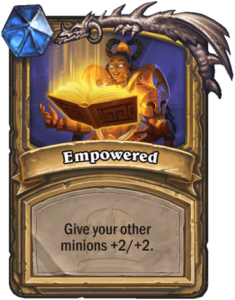

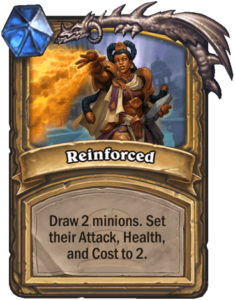
Amitus might have the most unique stats for a TITAN, but once you fully understand her abilities, you’ll realize it’s the most difficult TITAN to kill. Amitus puts an aura on herself and her fellow minions that they cannot take more than 2 damage at a time. This means that for Amitus to be removed through opponent minion trades, it needs to take at least FOUR hits! Add the fact she has taunt, and Amitus is one tough TITAN to get through, offering very strong protection for yourself and your board once she’s played. Her abilities aren’t a joke either.
Reinforced draws 2 minions and sets their cost, attack, and health to 2. Highly impactful battlecry minions or ones with strong static abilities or deathrattles could be very good targets. The Earthen package are strong draws. The Countess becomes insane, allowing you to play all invitations the very next turn. This ability has the potential to cheat a lot of mana.
Empowered is a big board buff. Combine it with Amitus’ inherent ability and your minions become even more difficult to kill. Amitus can act as a board-based finisher if you have the board lead.
Pacified is Amitus’ responsive tool, setting enemy minions’ attack and health to 2. This is a soft removal option if you’re facing big threats, but it essentially doesn’t change the opponent’s ability to kill Amitus through trades.
Amitus seems like a very flexible card. The fact Paladin can resurrect her in some archetypes makes her even more scary. The defensive utility and how much she can stall the game, the offensive utility by having both a board buff and making your minions increasingly difficult to remove, and the fact she’s the most difficult TITAN to kill and the most likely to stick another turn… You don’t pass on Amitus.
Score: 4
Final Thoughts
TITANS Set Rank: 7th
Overall Power Ranking: 5th
Paladin’s most impactful addition might not be a TITANS card, but a Core set card. Crusader Aura offers an extremely powerful win condition to initiative focused Paladin decks. This card is so good that it might deem the influential Horn of the Windlord an obsolete finisher in the class.
It is very likely that a Paladin deck will be one of the tone setters on the first week of the patch. As it tends to be, Paladin is often a litmus test for the rest of the field. A good candidate would be Mech Paladin. We’ll be clear: Mech Paladin looked like hot garbage in theorycrafting streams, but we think the reason why it looked so bad is that it didn’t run Crusader Aura.
For us, this is an obvious combo. You play Inventor’s Aura, vomit discounted mechs to the board, play Crusader’s Aura and win the video game. Mech Paladin has the card draw to back this up. It’s got the early snowballing capabilities and it’s got Bubblebot to protect a wide board from AOE.
Another possibility is that Pure Paladin incorporates a Silver Hand Recruit package to flood the board and execute a similar game plan, while maintaining its Countess win condition. Admittedly, we do tend to overestimate dudes. It doesn’t have to be dudes. Dudes didn’t work out in Festival of Legends, but Crusader Aura is exactly the kind of card that can make dudes work.
We sense one major problem in Paladin. Late game strategies in the class don’t look promising to us. We’re rooting for it. The Earthen package, if it works out, has the potential to attract a dedicated player base. A scaling late game is effective at capturing the hearts of players. Some players just like to summon larger and larger men. Relics are a good recent example. Librams were another Paladin package that was very memorable.
But Earthens are slow. They might be brutally slow in an upcoming format that could present a lot of late game lethality. Summoning larger and larger men might not be able to stand up to these strategies. Paladin’s late game could be eaten up and spat out.
Which means that this could be another expansion where Paladin is mostly an aggressive class that tries to end games early. A nightmare scenario is one in which Crusader Aura Paladin decks are too good, get nerfed hard and Paladin sits out the format until the mini-set because lots of players, especially at higher levels of play, have no interest in playing the class when it’s mediocre and has no attractive late game. Hopefully, that’s avoided.
All in all, we might end up copy pasting our analysis of Paladin in Festival of Legends for this expansion too. Hey, at least it saves us work!

Just like Starfox says: Thank you zacho! You really make it possible for me to enjoy this game in its full potential!
>If your opponent has a big threat on the board, Golganneth takes care of it.
Not if it has divine shield 🤣
Thx for the good work!
I always enjoy reading your stuff!
Thanks for the review. I appreciate your work. Good luck with the launch!
Of course it’s good with Implock; it’s an IMPrisoned Horror.
I don’t often see many comments on here, so I’ll just say thank you for all of your hard work on this. Not only are you analyzing every card and it’s possibilities, but you’re doing detailed write ups on the potential of each card. Every pre-expansion I look forward to this preview and it never disappoints!
first